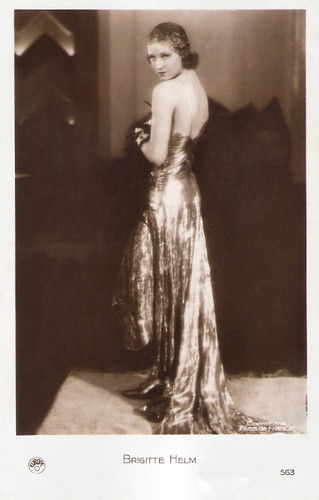
French postcard by Europe, no. 563. Photo: Cinéromans Films de France. Brigitte Helm in L'argent (Marcel L'Herbier, 1928), freely adapted from the novel by Emile Zola.

French postcard by Editions Cinémagazine, no. 411. Catherine Hessling as the title character in Nana (Jean Renoir, 1926), based on the homonymous novel (1880) by Émile Zola.

British postcard in the Famous Film Stars Series by Valentine's, no. 7123B. Photo: United Artists. Anna Sten in Nana (Dorothy Arzner, George Fitzmaurice, 1934).
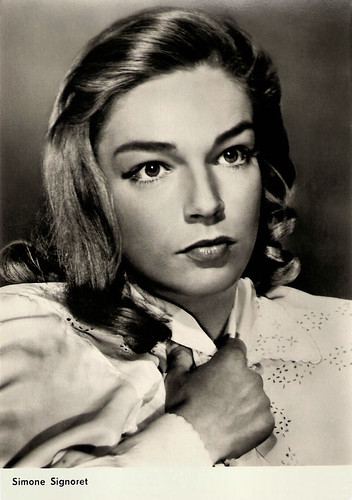
East-German postcard by VEB Progress Film-Vertrieb, nr. 1924. Photo: Simone Signoret in Therese Raquin Thérèse Raquin/The Adultress (Marcel Carné, 1953).

East-German postcard by VEB Progress Filmvertrieb GmbH., Starfoto no. 1288. Gérard Philipe and at right Dany Carel in the Zola adaptation Pot Bouille/Lovers of Paris (Julien Duvivier, 1957), released in Germany as Der schöne Octave.
Writing his true vocation
Émile Édouard Charles Antoine Zola was born in 1840 in Paris. He spent his childhood and school years in Aix-en-Provence, where his father Francesco Zola, of Italian origin, was an engineer. He was implementing a plan for a drinking water supply when he died unexpectedly. Poor years followed for Zola and his mother, Émilie Aubert. In 1858 they went to Paris.
From his earliest youth, Émile Zola was fascinated by literature. He read a great deal and very early on envisaged the idea of writing professionally. From an early age, he considered writing to be his true vocation. In the sixth grade, he had already written a novel about the Crusades. He told his childhood friends several times in his letters that one day he would be a recognised writer.
Zola failed his baccalauréat (bachelor of sciences) twice in 1859. These failures left a deep impression on the young man, who despaired of having disappointed his mother. He was also aware that, without a diploma, he would face serious material difficulties. In Paris, he became friends with Édouard Manet and other painters of the Impressionist movement. Manet depicted him several times in his paintings, and through Manet, he came into contact with the poet Stéphane Mallarmé.
In 1862, Zola found a job in the publicity department of the publishing house Hachette. There he met writers and became familiar with the practical side of being a writer. He learned all the techniques of books and their marketing. He also published as a journalist in various magazines. As a critic, he was particularly harsh on the official Salon jury when 'The Flute Player' by Manet was rejected. He would also become a fervent defender of impressionism.
Zola managed to get his first book published by Hetzel: 'Les Contes à Ninon' (1864). He became famous with novels such as 'Germinal', 'Nana' and the enormous success, 'L'Assommoir' (1877), which are part of the great cycle 'Les Rougon-Macquart'. 'Les Rougon-Macquart' is a twenty-volume novelistic fresco depicting French society under the Second Empire, which follows the trajectory of the Rougon-Macquart family through its different generations, each of whose representatives, from a particular period and generation, is the subject of a novel.
In 'L'Oeuvre' (1886), he depicts the tragic life of a painter, a character largely inspired by Paul Cézanne, a childhood friend of Zola's from Aix-en-Provence. Cézanne had introduced him to the graphic arts, and more particularly to painting. After receiving this novel, Cézanne abruptly ended their friendship, which had not been very intense for some time.
Zola's open letter to President Félix Faure in L'Aurore of 13 January 1898 under the title 'J'accuse...!' was also famous. In this letter about the Dreyfus affair, he sides with the Jewish captain Alfred Dreyfus, who was unjustly accused of espionage. Zola accused the French General Staff of producing evidence. Zola was sentenced for libel to one year in prison and a 3000 Francs fine, which was paid for him by Octave Mirbeau. On the advice of friends, Zola did not wait for the appeal and fled to Britain. After a year he was able to return and was received as a hero.
Zola married Alexandrine 'Gabrielle' Meley in 1870, a working-class woman who had been a model for Impressionist painters such as Manet. She introduced him to the people on the fringes of society in Paris. She also organised weekly literary dinners for Zola to further his career. Zola also had a mistress, Jeanne Rozerot, who was the family laundress. While his marriage remained childless, he and Jeanne had two children.
Émile Zola died unexpectedly in Paris in 1902 at his home on the Rue de Bruxelles due to carbon monoxide poisoning. According to Philipp Blom, a roofer confessed to placing a piece of wood on the chimney to kill the writer in revenge for his defence of the Jewish captain. In 1908, his body was transferred to the Panthéon.

French card. Photo: Gerschel. Émile Zola.

Vintage French postcard. Scene from the play 'Nanà' by William Busnach, a play in five acts adapted from the novel by Émile Zola. Théâtre de l'Ambigu, Paris. Tableau 1, The Blonde Venus. The play was first performed at the Théâtre de l'Ambigu on 6 February 1904.

Vintage French postcard. Scene from the play 'Nanà' by William Busnach, a play in five acts adapted from the novel by Emile Zola. Théâtre de l'Ambigu. Tableau 2, The Ruins of Chamont. The play was first performed at the Théâtre de l'Ambigu on 6 February 1904. Nanâ was played by Armande Cassive. It was one of her most memorable roles.

French postcard by P. Helmlinger & Co., Nancy. Cliché: N. (Nadar). Promotion for the Théâtre Moncey's production of Émile Zola's novel 'L'Assommoir' (24 February - 3 March 1905). Çaption: The death of Gervaise (Hélène Petit). This postcard shows a photo from the 1879 first stage adaptation, starring Hélène Petit as Gervaise, Gil Naza as Coupeau, and Angelo as Goujot. The original photos were by Nadar.
In 1879, two years after its publication, Émile Zola's novel 'L'Assommoir' was adapted for the stage by William Busnach and Octave Gastineau, with the help of Zola. The premiere took place on 18 January 1879 and was a great success. Afterwards, the play was often re-staged, in and outside of France. From 24 February 1905, the play was staged at the Parisian Théâtre Moncey, 50, Avenue de Clichy. The journal La Presse of 26 February 1905 lauded the play and the performances, in the first place by M. Pouctal as Coupeau, Gabrielle Fleury as Gervaise, and M. Lemarchand as Lantier. Also praised were Mlle Delorme, Mme Gaudy, and M. Berthon as Lorilleux. Of course, there were tears, but also many laughs over the drunkards Mes-Bottes, Bec-Salé, and Bibi-la-Grillade, played by Mori, Prika, and Martin. The first night took place before a packed crowd.

French postcard by Croissant, Paris, no. 3678. Photo: Film Pathé. Publicity still for Les victimes de l'alcoolisme/Alcohol and Its Victims (Ferdinand Zecca, 1902).
Les victimes de l'alcoolisme/Alcohol and Its Victims (Ferdinand, Zecca, 1902) is a four minutes short, directed, and written by Ferdinand Zecca. It was based on 'L'Assommoir', and the first Zola film adaptation ever. Les victimes de l'alcoolisme/Alcohol and Its Victims tells a moral story of what happens to a man if he starts to drink and gamble. Bob Lipton at IMDb: "this is a very advanced film for 1902, being offered in five scenes, on elaborately painted sets. It was probably not intended solely for movie programs, but for anti-booze lectures, Chautauquas, and conferences."

French postcard by Croissant, Paris. Photo: Film Pathé. Publicity still for Au pays noir/Tragedy in a Coal Mine (Ferdinand Zecca or Lucien Nonguet, 1905). Caption: In the mine galleries. This refers to the 5th scene of the film.
Au pays noir (1905) was partly inspired by Émile Zola's novel, the popular workman's drama 'Germinal' (1885). Au pays noir narrates the life of the miner: his life at home, going to work, gathering at the pit and descending, and having a break. But then an explosion takes place and water crushes the beams that uphold the galleries, killing the miners. A few manage to escape and withdraw to a higher gallery where the water can reach them only to their middle. They hear their liberators, who finally free them. Outside, gendarmes try to hold the crowd, who, frightened, see the rescuers bringing dead bodies one by one to the ground. When the foreman's dead son is brought to earth, his father explodes with grief and clenches his fist against the murderous mine. A year after the film, the worst mine disaster in Europe occurred in Courrières, France, when on 10 May 1906 a coal dust explosion killed almost 1100 mine workers. Zola's 'Germinal' was already filmed by Ferdinand Zecca in 1903. In 1912 Victorin Jasset filmed for the Eclair company another liberal adaptation, Au pays des ténèbres, while Albert Capellani filmed Germinal under its own title in 1913.

Spanish collectors card by Chocolat Imperial, no. 1 (in a series of 18 chromos). Photo: Caesar Film / J. Gurgui, Barcelona. Tilde Kassay in Una donna funesta/Nanà (Camillo De Riso, 1917-1919). Tilde Kassay (1887-1964), was an Italian silent film actress between 1915 and 1921.

Italian postcard by IPA CT. V. Uff. Rev. St., Terni., no. 5076. Photo: Tiber Film. Hesperia in La Cuccagna (Baldassarre Negroni 1917). Caption: "Massimo had been raised in a provincial college." The film was an adaptation of Emile Zola's 'La curée'. Hesperia is Renata/Renée, the second wife of the cunning and wealthy Saccard, who married young Renata for her money. She has an affair with Saccard's son Max (Massimo), played by Alberto Collo. In the end money triumphs instead of love, just as in Zola's novel.
In search of truth
Emile Zola paints the society of the Second Empire in all its diversity, highlighting its harshness towards the workers ('Germinal', 1885), its turpitude ('Nana', 1880), but also its successes (the advent of department stores in 'Au Bonheur des Dames', 1883).
In a search for truth that takes scientific methods as a model, Émile Zola accumulates direct observations and documentation on each subject. With his acute sense of detail "that rings true" and of effective metaphor, with the rhythm of his sentences and his narrative constructions, he creates a powerful fictional world, inhabited by anguished questions about the human and social body.
Émile Zola's work has been widely adapted to film, with more than 150 films and TV movies based on his works, in various languages. The first adaptations were of 'L'Assommoir', by Ferdinand Zecca, under the titles Le Rêve d'un buveur (1898) and Les Victimes de l'alcoolisme (1902).
In addition to L'Assommoir, more than half of the titles in the Rougon-Macquart series have been adapted for the screen. Some, such as 'Nana' and 'Germinal', have been adapted several times, with varying degrees of faithfulness to the original works.
Apart from the Rougon-Macquart cycle, the only work by Zola that has been widely adapted for the screen is 'Thérèse Raquin', but several of his short stories have also been adapted.
In 1937, the French novelist inspired the Hollywood production The Life of Emile Zola, directed by William Dieterle and starring Paul Muni, which won the 1938 Academy Award for Best Picture.

French postcard by J.R.P.R., Paris, no. 337. Photo: Studio Lorelle (Lucien Lorelle), Paris. Brigitte Helm in L'Argent/The Money (Marcel L'Herbier, 1928).
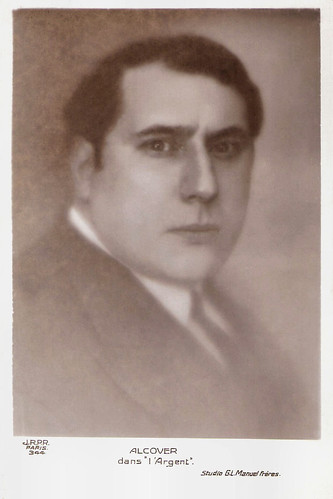
French postcard by J.R.P.R., Paris, no. 344. Photo: Studio G.L. Manuel Frères. Pierre Alcover in L'Argent/The Money (Marcel L'Herbier, 1928).
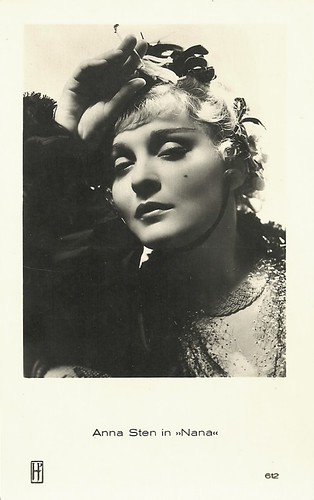
Dutch postcard by JosPe, Arnhem, no. 612. Anna Sten in Nana (Dorothy Arzner, George Fitzmaurice, 1934). Strikingly beautiful Anna Sten (1908-1993) was a Ukrainian-born actress, who became the most famous, or rather, the most notorious of the many ‘new Greta Garbos’ of the 1930s.

French postcard in the Collection Noire by Editions Hazan, Paris, no. 6011, 1988. Photo: Sam Levin. Director Jean Renoir at the set of La bête humaine/The Human Beast (1938).

East-German postcard by VEB Progress Film-Vertrieb, Berlin, no. 1925. Retail price: 0,20 DM. Photo: Raf Vallone and Simone Signoret in Thérèse Raquin/The Adultress (Marcel Carné, 1953), after the novel by Emile Zola.

German postcard by Kolibri-Verlag, Minden/Westf., no. 2230. Photo: Columbia. Maria Schell in Gervaise (René Clément, 1956).

East-German postcard by VEB Progress Filmvertrieb, no. 1294, 1960. Photo: Dany Carrel, Gérard Philipe and Danièle Darrieux in Pot-Bouille/Lovers of Paris (Julien Duvivier, 1957), adapted from the novel by Zola.
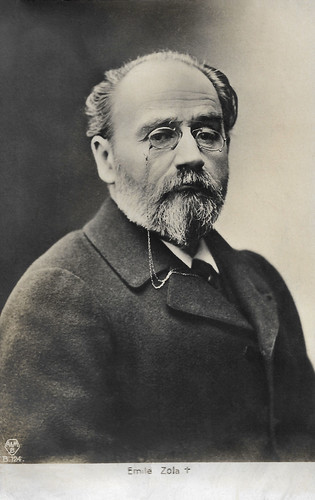
French postcard by A & M, B., no. B 124. Emile Zola.
Sources: Gallica (French), Bob Lipton (IMDb), Wikipedia (French and Dutch), and IMDb.
No comments:
Post a Comment